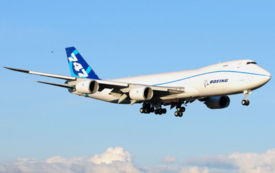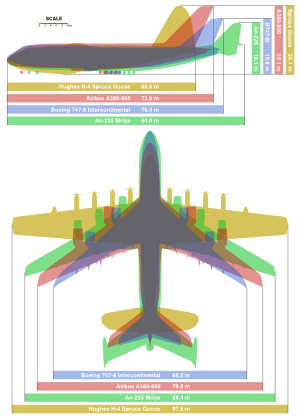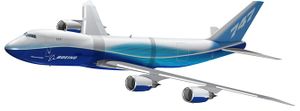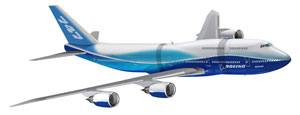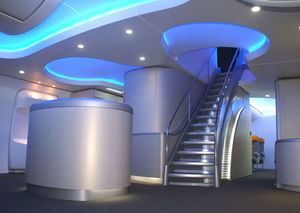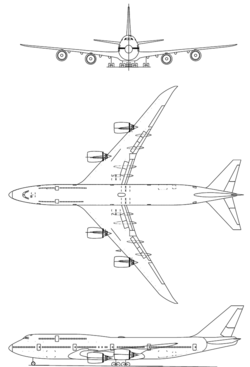PlaneSpottingWorld welcomes all new members! Please gives your ideas at the Terminal.
Boeing 747-8
| Boeing 747-8 | |
|---|---|
| The Boeing 747-8F during the 747-8's maiden flight on February 8, 2010 | |
| Type | Wide-body jet airliner |
| Manufacturer | Boeing Commercial Airplanes |
| Maiden flight | February 8, 2010[1] |
| Status | Testing/early production |
| Number built | 3 |
| Unit cost | $293-308 million (747-8I)[2] $301.5-304.5 million (747-8F) |
| Developed from | Boeing 747-400 |
The Boeing 747-8 is the latest variant of the Boeing 747, officially announced on November 14, 2005 as an evolutionary development of the Boeing 747-400. Prior to the formal 2005 announcement, it was known publicly as the 747 Advanced.
Contents
Background
The 747-8 will use the same engine and cockpit technology as the 787. Boeing named the new airliner "747-8" because of the technology it will share with that aircraft. Before the official launch of the 747-8, Boeing had plans to develop other variants of existing 747 models under the names 747X (Experimental) and 747-400XQLR (Experimental Quiet Long-Range). These designations were dropped in favor of the 747 Advanced program, which evolved into the 747-8.
Boeing says that the new design will be quieter, more economical and more environmentally friendly than previous versions of the 747. As a derivative of the already common 747-400, the 747-8 has the economic benefit of similar training and interchangeable parts. Certification is another area where savings can be made compared with the new design of the Airbus A380.
The 747-8, as the current new development of Boeing's largest airliner, is notably in direct competition on long haul routes with the A380, a full length double-deck aircraft also being developed and pre-sold at a similar time. For airlines seeking very large passenger airliners, the two have been pitched as competitors on various occasions. Following delays to the A380 program some airlines switched (or stated they are considering switching) their orders to the 747-8 instead.[3]
Variants
The 747-8 is a development of the venerable Boeing 747 which takes advantage of improvements in technology and aerodynamics. The two variants of the 747-8 were launched in 2005, and as of 2006 will both feature a fuselage stretch of 18.3 ft (5.6 m) over the 747-400, bringing the total length to 250 ft 2½ in (76.4 m). The stretch would mean that the 747-8 would be the world's longest airliner, surpassing the Airbus A340-600 by 1.1 meter. The 747-8 Freighter will enter service in 2009, while the passenger 747-8 Intercontinental will be introduced in 2010.
747-8 Freighter
The 747 has proven to be a very popular freighter, carrying roughly half of the world's air freight.[4] In an effort to maintain this dominant position, Boeing has designed a freight variant of the 747-8, dubbed 747-8 Freighter or 747-8F. The 747-8F will be the initial model to see entry into service (EIS). As on the 747-400F, the upper deck is shorter than passenger models; the 18 ft 3½ in (5.6 m) stretch is just before and just aft of the wing. With a 970,000 lb (440 tonne) maximum take-off weight, it will have a total payload capability of 308,000 lb (140 tonnes) and a range of 4,475 nm (8,275 km, 5,140 mi).[5] Four extra pallet spaces will be created on the main deck, with two extra containers and two extra pallets on the lower deck.
The 747-8 will have more payload capacity but less range than the current 747-400ERF. When Boeing launched the ERF, all of the 35,000 lb increase in MTOW over the 747-400F (875,000 lb to 910,000 lb) allowed airlines to takeoff with more fuel, burn it during flight, and land at the same weight as the regular 747-400F. This increased the range of the 747-400ERF compared to the 747-400F. Cargo carriers such as Cargolux often move machinery or indivisible loads that require a plane with a higher payload and landing capability. As with all planes, range is given with maximum payload not fuel. The 747-8's 60,000 lb MTOW increase (970,000 lb) has been directed exclusively to its Zero-Fuel weight or payload capacity. If taking off at maximum payload, the 747-8 takes off with its tanks roughly half empty. On trips where the payload is not at maximum, the plane can therefore take on more fuel and extend its range.
Cargolux announced on July 27, 2005 its desire to buy a minimum of ten 747-8 Freighters, for delivery in 2009, with options for 10 more. The 747-8 was formally launched on November 14, 2005 by Cargolux and Nippon Cargo Airlines (NCA), which ordered eight 747-8Fs. NCA currently operates 11 747 freighters, 8 -200s & 3 -400s with ten 747-400Fs currently on order.[6] On 8 October 2006 Emirates Airline announced a deal to purchase ten 747-8Fs, with an option for ten more.[7] On December 29, 2006, Boeing and Korean Air announced an order for five 747-8Fs.[8]
747-8 Intercontinental
The passenger version (dubbed 747-8 Intercontinental or 747-8I) will be capable of carrying up to 467 passengers in a 3-class configuration over 8,000 nautical miles (14,816 km) at 0.855 Mach. The 747-8I will carry 51 more passengers and two more freight pallets than the 747-400. Despite initial plans for a shorter stretch than the freighter model, the two variants will be the same length, increasing passenger capacity and allowing easier modification of the 747-8I to freighter use.[1] New engine technology and aerodynamic modifications extend its range, allowing non-stop flights such as Hong Kong – New York or Sydney – Dallas/Fort Worth. However, firm configuration is only expected for next year.
For the time being, the General Electric GEnx, which is one of the two powerplant choices currently offered for the 787, will be the only engine available for the 747-8. However, similar to the GEnx variant offered on the Airbus A350, the 747 variant will be adapted to provide bleed-air for conventional aircraft systems and feature a smaller diameter to fit on the 747 wing.
Some carbon fiber reinforced plastic will be utilized in the 747-8's airframe to reduce weight; however structural changes will mostly be evolutionary rather than revolutionary with respect to the 747-400. The 747-8 will feature an enhanced wing with improved aerodynamics. It will have single-slotted outboard flaps and double-slotted inboard flaps. Raked wingtips, similar to the ones currently on the 777-200LR and 777-300ER models and the 787-8 and 787-9 design, will replace the winglets on the 747-400. These structures help reduce the wingtip vortices at the lateral edges of the wings, decreasing wake turbulence and drag and thereby increasing fuel efficiency.
For the 747-8, Boeing has proposed some changes to the interior layout of the aircraft. Most noticeable will be the stairway to the upper deck. On present 747-300 and -400 models, the stairway is straight, narrow, and runs from the galley area located at door 2 (the second door from the front of the aircraft), to the back of the upper deck, on the left hand side. The stairway on the 747-8I will be a curved, sweeping staircase. Originally proposed to be on the right-hand side, it has been moved back to the left-hand side after Lufthansa's order. The window line will be extended to where the stairway reaches the upper deck, and a further set of windows may be placed overhead.
Further down the aircraft, it has been proposed to put "SkySuites" in the "crown" area (the space above the passenger cabin, currently used for air conditioning ducts and wiring). The wiring and ducts will be moved to the side to create space for these facilities — consequently they will not have windows. The SkySuites will be small individual compartments with sliding doors or curtains, and which may feature beds, seating, and entertainment or business equipment. A common lounge area would also likely be provided. Boeing has also proposed smaller, more modest "SkyBunks". Access to the crown area would be via a separate stairway at the rear of the aircraft. Passengers using the SkySuites, which will be sold at a premium price, will sit in regular economy class seats for take off and landing, and move to the crown area during flight.
The main cabin uses an interior similar to that of the 787's. Overhead bins are curved, and the center row is designed to look as though it is attached to the curved ceiling, rather than integrated into the ceiling's curve like on the 777. The windows will also be of similar size to the type used on the 777 and the 767-400ER, which are 16% larger than on the current 747-400s. The 747-8 will feature a new solid state light-emitting diode (LED) lighting system. It will be possible to create various moods in the cabin, from sunrise to sunset, making travel a more comfortable and relaxing experience. At the same time, LED technology offers additional advantages regarding lower maintenance costs and longer intervals between unscheduled repairs.
Lufthansa launched the 747-8I on December 6, 2006, becoming the first airline to order the variant.[2] Though solitary VIP orders had been placed, Lufthansa will receive the first 747-8Is off the production line. Other airlines such as Japan Airlines (as the operators of the largest 747 fleet), Northwest Airlines (as the launch customer of the 747-400), Pakistan International Airlines, China Airlines and Cathay Pacific are viewed as other potential 747-8 operators, given their historical links with Boeing and the fact that none of them have purchased the Airbus A380 as of yet.
Orders and deliveries
This plane has not yet entered service. As of 2007, the following orders have been taken.
| Date | Airline | EIS | Type | ||
|---|---|---|---|---|---|
| 747‑8I | 747‑8F | Options | |||
| November 15 2005 | 2009 | 10 | 10 | ||
| 2009 | 8 | 6 | |||
| May 30, 2006 | 2010 | 1 | |||
| September 11, 2006 | 2010 | 12 | 14 | ||
| September 15, 2006 | 2010 | 1 | |||
| September 26, 2006 | 2010 | 1 | |||
| September 30, 2006 | 2010 | 10 | |||
| November 6, 2006 | 2010 | 1 | |||
| November 30, 2006 | 2009 | 4 | 2 | ||
| November 30, 2006 | Unidentified | 5 | |||
| December 6, 2006 | 2010 | 20 | 26 | ||
| December 28, 2006 | 2010 | 5 | |||
| Sub-totals | 24 | 54 | 52 | ||
| Totals | 78 | ||||
- Entries shaded in pink have been announced, but have not yet signed a firm contract..
*There is speculation on who the first BBJ customer is. Three articles [14] [15] [16] suggest or state that it is the Qatar Government. It has also been suggested that the unidentified customer may be Saudi Arabian Airlines, but the article quoted [17] does not seem to confirm this. Planes purchased through the Boeing Business Jet division are delivered in "green" condition meaning there are no interiors and external livery paint is not applied.
Marketing and sales performance
- British Airways announced on November 3, 2006 that they have asked Boeing and Airbus for bids to provide replacements for 34 long-haul airliners and additional aircraft for fleet expansion. BA is reportedly considering all variants of long haul aircraft from both companies, including the 747-8. General Electric and Rolls Royce have also been invited to provide bids for engines and engineering services. Analysts at UBS expect the aircraft order will be placed with one manufacturer to simplify maintenance. The lack of a Rolls Royce engine for the 747-8 may also have an impact on the order. BA are traditionally very supportive of Rolls Royce and are one of the largest RR customers.[9][10][11]
- Because of the mounting delays of Airbus' A380, some airlines are believed to be considering cancelling or scaling down their orders of the A380 in favor of the Boeing 747-8.[3]
Specifications
| Measurement | 747-8I | 747-8F |
|---|---|---|
| Cockpit crew | Two | |
| Seating capacity | 467 (3-class) | N/A |
| Length | 250 ft 8 in (76.4 m) | |
| Wingspan | 224 ft 7 in (68.5 m) | |
| Height | 64 ft 2 in (19.5 m) | |
| Cabin width | 20 ft (6.1 m) | |
| Zero fuel weight | 610,000 lb (276,691 kg) | 702,000 lb (318,422 kg) |
| Maximum take-off weight | 970,000 lb (439,985 kg) | |
| Cruising speed | 0.855 Mach | 0.845 Mach |
| Range fully loaded | 8,000 nm (14,815 km) | 4,475 nm (8,275 km) |
| Cargo capacity | 5,705 ft3 (161.5 m³) | 30,177 ft3 (854.3 m³) |
| Service ceiling | 43,000 ft (13,100 m) | |
| 4× Engines | GEnx-2B67 | |
| 4× Thrust | 66,500 lbf (296 kN) | |
Trivia
- Plans to extend the length of the 747 were first discussed in 1972; it took 33 years before Boeing committed to a longer version, whereas plans to shorten the 747 were first discussed in 1973, and it took one year before a commitment to the 747SP was made.
- With a 970,000 lb (439,985 kg) maximum take-off weight, the 747-8 is the heaviest aircraft ever offered by Boeing, commercial or military.
References
- ↑ Steinke, Sebastian (January 2006). BOEING LAUNCHES 747-8. FLUG REVUE.
- ↑ Kingsley-Jones, Max (2006-02-17). Boeing's 747-8 vs A380: A titanic tussle. Flight Global. Retrieved on 2006-09-13.
- ↑ 3.0 3.1 Robertson, David. "Airbus will lose €4.8bn because of A380 delays", The Times Business News, October 4, 2006.
- ↑ "Boeing 747-400 Freighter Family: The World's Best Freighters." Boeing 747-400 Freighter Family.
- ↑ "Boeing 747-8 Intercontinental and 747-8 Freighter." Boeing 747-8I and 747-8F Facts.
- ↑ "Boeing Launches New 747-8 Family." Boeing press release. November 14, 2005.
- ↑ "Emirates plans $5.6-billion Boeing order". Agence France-Presse, globeandmail.com. 9 October 2006
- ↑ "Boeing Finalizes 25-Airplane Order with Korean Air." Boeing press release. December 29, 2006.
- ↑ Bloomberg News 3rd November 2006
- ↑ Vanguard October 16th 2006
- ↑ Rolls Royce Market Outlook 2006-2025
External links
- Boeing 747-8 on Boeing.com
- Boeing 747-8 | The Shape of the Future
- Boeing 747-8 airport planning guide
Related content
Related development
Comparable aircraft
Related lists
See also
Boeing airliners | |
|---|---|
| Piston-engined | |
| Jet-engined | |
| In development | |
| Proposed | |
| Not developed | 2707 · 7J7 · NLA · Sonic Cruiser |
Lists relating to aviation | |
|---|---|
| General | Timeline of aviation · Aircraft · Aircraft manufacturers · Aircraft engines · Aircraft engine manufacturers · Airports · Airlines |
| Military | Air forces · Aircraft weapons · Missiles · Unmanned aerial vehicles (UAVs) · Experimental aircraft |
| Notable incidents and accidents | Military aviation · Airliners · General aviation · Famous aviation-related deaths |
| Records | Flight airspeed record · Flight distance record · Flight altitude record · Flight endurance record · Most produced aircraft |
Giant aircraft | |
|---|---|
| Production | |
| Prototypes | |
| Concepts | Proposed: Airbus A380-900 · Reaction Engines A2 · Beriev Be-2500 · Boeing 747-8 · Abandoned: Boeing New Large Airplane · Boeing Pelican · McDonnell Douglas MD-12 |
| Wingless aircraft | Biggest airship: Luftschiffbau Zeppelin Hindenburg class · Biggest blimp: Goodyear ZPG-3W · Biggest helicopter: Mil Mi-12 |
fr:Boeing 747-8 nl:Boeing 747-8 Intercontinental ja:ボーイング747-8 no:Boeing 747-8
